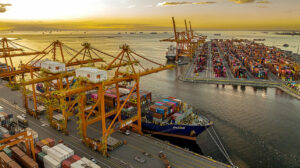Philippine April trade gap narrows

THE PHILIPPINES’ April trade deficit narrowed month on month to $4.8 billion, as exports slightly picked up and imports grew at their slowest pace in 13 months amid the Russia-Ukraine war and supply chain disruptions.
Preliminary Philippine Statistics Authority data showed the value of merchandise exports grew by 6% year on year to $6.129 billion in April, the fastest since 15.8% recorded in February.
The export expansion was slightly up from 5.9% in March, but slower than 74.1% a year ago.
“Based on the PSA’s preliminary data, April 2022 was estimated to be 14.5% higher than the pre-pandemic average from 2017 to 2019,” the Department of Trade and Industry (DTI) said in a separate statement.
The country’s merchandise imports rose by 22.8% to $10.902 billion in April, the slowest since 22.1% in March 2021.
Import growth eased from 153.2% in the same month last year and 27.7% in March.
The trade-in-goods deficit narrowed to $4.773 billion, from the record $5.007-billion gap in March. However, it was wider than the $3.098-billion shortfall a year ago.
For the first four months, exports jumped by 8.9% year on year to $25.551 billion, above the revised 7% growth projected by the Development Budget Coordination Committee (DBCC) for this year.
Imports climbed by 26.7% to $44.219 billion during the period, well above the government’s revised 15% goal for 2022.
Year to date, the trade balance has ballooned to a $18.668-billion deficit.
“The slight increase in exports in April is actually a continuation of the falling trend in exports after February 2022,” University of Asia and the Pacific Senior Economist Cid L. Terosa said in an e-mail.
This reflected global market jitters arising from the Russia-Ukraine war and weaker global demand because of the strict lockdowns in China.
“Without these external events, I believe exports would have grown faster,” Mr. Terosa said.
He also attributed the uptick in exports and slower import growth to base effects.
“Imports in April grew slower than March because production activities have been affected by the protracted geopolitical tension, oil price increases, and disruption in supply chains worldwide,” Mr. Terosa said.
Security Bank Corp. Chief Economist Robert Dan J. Roces said the Russia-Ukraine war, elevated inflation and coronavirus lockdowns were downside risks to the Philippine trade and manufacturing outlook.
“On the output side, headwinds are apparent as capacity utilization weakened while producer price inflation accelerates, so this affects the export side,” he said in an e-mail.
“Imports, on the other hand, are costlier with a depreciating peso, but this is expected to outpace exports with higher capital and consumption goods demand in the medium term,” Mr. Roces said.
Since the Russia-Ukraine conflict that started in February, global crude oil prices have climbed above $100 per barrel amid supply concerns. Russia is the world’s second-largest oil producer.
Outbound shipments of manufactured goods, which accounted for 76.1% of total exports in April, slipped by 1% year on year to $4.661 billion.
Electronic products, which made up 70% of manufactured goods and more than half of total exports that month, inched up by 0.8% to $3.250 billion. Three-fourths of electronic product sales came from semiconductors, which increased by 2% to $2.461 billion.
The DTI said coconut products contributed nearly half or $164 million of the $348-million additional exports in April.
“This was primarily driven by exports of coconut oil which grew 2.5 times its export level compared with last year. Since February 2021, exports of coconut oil have been increasing at double-digit growth rates,” it said.
Meanwhile, the country’s orders of raw materials and intermediate goods rose by 18.6% to $4.279 billion in April. These accounted for more than a third of the total April import bill.
Imports of capital and consumer goods were valued at $2.939 billion (up 3.4%) and $1.598 billion (up 7.1%), respectively.
Mineral fuels, lubricants and related materials more than doubled to $2.012 billion from $861.820 million last year.
China, which accounted for 15.9% ($971.743 million) of the total receipts, was the top destination of locally made products. It was followed by the United States (15.6% or $955.170 million) and Japan (13.4% or $820.962 million).
Likewise, China was the country’s main source of imports, with a 20.8% share ($2.269 billion) of the total bill, followed by South Korea (11.1% or $1.205 billion) and Indonesia (9.3% or $1.009 billion).
Mr. Terosa said as long as external headwinds persist, achieving the government targets for export and import growth this year would be challenging.
“Without these external events, the country would easily exceed both export and import targets for 2022,” he said. — Lourdes O. Pilar




